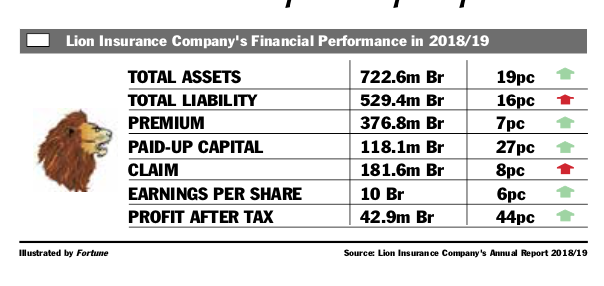
Radar |
Mar 7 , 2020
By Wasihun Mekonen
The Ethiopian insurance industry may be about a century old but it has barely developed to play a significant role within the economy. The introduction of an independent regulatory organ to oversee the industry may go a long way in developing a sector that has been long overlooked, writes Wasihun Mekonen (wasirise@gmail.com), a legal attorney that has worked for different insurance companies and participated in various insurance related researches and symposiums.
The insurance business was introduced to Ethiopia slightly over a century ago. Through those years, under the regulation and supervision of the National Bank of Ethiopia (NBE) for nearly half a century now, its development has been affected by political, economic and social factors.
The Ethiopian insurance market and its contribution to national GDP has been very minimal. The insurance industry arguably showed better performance during the reign of Emperor Haile Selassie, since local insurers were allowed to work in partnership with foreign insurance companies.
Following the 1974 revolution, all of the existing 13 insurance companies were nationalised and merged. What followed was the establishment of the Ethiopian Insurance Corporation (EIC). A proclamation by the Dergueplaced it, along with the state-owned banks, under the direct control and supervision of the central bank. The EIC functioned as a monopoly for nearly two decades until 1994.
After the overthrow of the Dergue, a new economic policy replaced central economic planning with a market-oriented system and allowed a certain amount of space for the private sector. Some private insurance companies were formed during the early 1990s. Until 2017, sixteen private insurance companies, one government insurance company and one local re-insurer had been established. Yet the development of the insurance industry is nascent.
The major reason for such low-rate growth is related to the institutional framework for the regulatory organ of the industry. This starts from the Insurance Fund Administrative Agency (IFAA), an organ of the federal government under the Ministry of Transport. Its major functions and roles are restricted to the administration of third-party motor insurance funds. It is also mandated to advocate for and create awareness regarding road accidents, emergency mediation and vehicle insurance against third-party risks.
It was established by the Council of Ministers to study the collection and disbursement of insurance fund and implementation; pay compensation to vehicle accident victims in accordance; collect data on deaths, bodily injuries and property damage caused by vehicle accidents with respect to which compensations have been paid. When necessary and after obtaining approval from the Ministry, the Agency can also delegate some of its activities to the appropriate institutions; print insurance certificates and stickers using the Insurance Fund; and collect and reimburse the cost to the Fund based on the quantities distributed to the insurance companies.
Why did the government establish the IFAA independently of the insurance industry?
What the IFAA did is what an insurer does at a department level. Third-party insurance can be purely provided by insurers - both the underwriting and the claim settlement processes. Although the government needs to be commended in making this type of insurance compulsory, the necessity of establishing the Agency without the knowledge of the insurance industry as an independent government organ that engages in the insurance business is difficult to understand.
At the time the regulation arrived, it was surprising even to the insurance industry. The popular agreement is that the Agency is a clear manifestation of the government’s intentions to usurp the major business source of the industry. It showcases the level of the government’s long intervention in the insurance sector. Considering the pure insurance nature of the Agency’s work, Ethiopian insurance experts strongly suggest a common interest industry representative to undertake the roles of the Agency’s fund administration.
Another organ whose establishment is not entirely clear is the Ethiopian Health Insurance Agency, which was established by the Council of Ministers in 2010. The social health insurance scheme was established to provide a basic package of essential health services to all Ethiopians. This would reduce out-of-pocket spending at the point of service delivery through the collection of premiums to increase the resources for health facilities.
Medical services that were allowed to be covered by the scheme were outpatient care, inpatient care, delivery services, surgical services and diagnostic tests and generic drugs included in the drug list of the Agency and prescribed by medical practitioners.
However, the scheme was not the success that it promised to be. Hence, the Agency, which is accountable to the Health Ministry, was forced to introduce schemes similar to this one, such as community-based health insurance (CBHI). The latter was developed to offer health care coverage for those in the informal sector, as the country attempted to make universal health coverage a reality.
Here again, why did the government engage in the administration of the medical insurance business, which is something that could have been tackled by the insurance companies?
There is no definite answer except that it is yet another manifestation of the government’s intervention in the insurance business. It is a source of business with huge potential that should have been left to the insurance companies.
The fundamental limitations of the industry do not end here. The legal and institutional framework under which the Ethiopian insurance market operates is not rewarding. Numerous rules, regulations and directives have entangled the industry’s performance. These include laws that limit insurers’ investment ratio and shareholding limit. The number of board members is also not allowed to be less than nine, and there are punishing restrictions to remunerations to the board members or their involvement in any other competing company.
The limitations and regulatory failures in Ethiopia are far from what is the case in other African countries where the industry operates under an independent professional regulator that gives the maximum concern to the perpetual development of the insurance business.
Take Kenya, for example. The country has the Insurance Regulatory Authority (IRA), a government agency established to practice regulation and supervision that enables industry players to be innovative and entrepreneurial. It works collectively and individually with industry players to achieve the overall development of the industry.
Before the Authority came into existence in 2006, the Kenyan insurance market was characterised by multifaceted problems and stiff competition. Some of the challenges were pricing regulations that are not followed by other players, fraudulent claims, cartels and monopolistic practices by hospitals and health providers. There was also the challenge of collecting outstanding premiums from delinquent brokers, lack of agent retention, lack of public awareness about the various insurance products that are offered and difficult clients who do not want to accept their policy's terms and conditions.
Other problems included broker dominance in corporate business, which lead to undercutting, policy-holders’ apathy and ignorance about their rights and understanding of the difference between banking and insurance, price competition, which results in the pricing of insurance products at uneconomical premiums and terms. Certainly, a compromised justice system, lack of rights to access claims from governmental institutions (hospitals or police) and the lack of a blacklisting system to punish fraudulent agents, did not help either.
The IRA adhered to the financial inclusion agenda by promoting consumer education and fostering consumer protection. It strengthened its supervisory framework through the introduction of risk-based supervision and enhanced its institutional capacity through training of insurance agents and actuarial scholarships. It improved the ease of doing business through digitisation and collaboration with relevant government agencies in combating financial crimes, especially fraud and money laundering. The Authority has also simplified and standardised insurance contracts in an effort to make it easier for policyholders and the general public to understand insurance contracts. These made the Kenyan insurance sector relatively stable and resilient.
Nigeria is another excellent example. The National Insurance Commission is the regulator of the insurance business in Nigeria that was established to ensure the effective administration, supervision, regulation and control of the insurance business in Nigeria. It also protects insurance policyholders, beneficiaries and third parties to insurance contracts.
Nigeria’s insurance industry practice, before the Commission, was undercapitalised and weak. It was not fulfilling its role of economic transformation. After its establishment, it worked to deepen insurance market penetration. It also introduced several initiatives, including the Market Development & Restructuring Initiative with the primary objective of promoting insurance culture in the country.
Its focus spanned the enforcement of compulsory insurance, sensitisation and modernisation of the sector’s agency system, eradication of unlicensed insurance institutions as well as the introduction of risk-based supervision. It evaluates the market continually and identifies the ‘drivers’ and drags’ of Nigeria’s insurance sector and designs a periodic and strategic plan to deal with them.
Yet another excellent African example is Ghana. The National Insurance Commission, established to ensure effective administration, supervision and regulation of the industry, is mandated to perform a broad spectrum of functions. These included licensing of entities, setting of standards and facilitating the setting of codes for practitioners. The Commission is also mandated to approve rates of insurance premiums and Commission pays, provide a bureau for the resolution of complaints and arbitrate insurance claims when disputes arise.
Before the Commission, the Ghanaian insurance market was characterised by poor public perception of insurance that resulted in a lack of confidence in the industry. A previously existing legislation that demanded that government and parastatal agencies insure solely with State the Insurance Corporation (SIC) was a drawback on industrial competition and efficiency. There were limited local private avenues for investment as well, and the number of insurance companies and insurance broking companies was too high, making it hard to regulate them.
NIC has worked to improve the efficiency of the industry and set the stage for the transformation and growth of the industry. It endeavoured to increase the national penetration rate. It issued the Mobile Insurance Market Conduct Rules to regulate the sale and distribution of insurance through mobile phones. It also implemented risk-based supervision to comply with the International Association of Insurance Supervisors’ (IAIS) core insurance principles.
In these three countries, the insurance industry plays a more significant role in their economies compared to that of Ethiopia. The insurance industry comprised, on average, over 1.5pc of their GDPs in 2017. In Ethiopia, the industry makes up 0.3pc of GDP.
We have also noticed the various efforts made by the regulators to expedite the development of the insurance industry. The effect of having “an owner to the industry” plays an unparalleled role in developing the insurance industry, working to deepen market penetration of insurance and tasking it with widening coverage.
Such “owners” are also primary sources of industry data. They work relentlessly to empower the industry’s human power formally and institutionally. They devise short, middle and long-term strategic plans to tackle prevailing challenges. They are keen to identify problems and immediately implement workable solutions. They are proactive and actively responsive to industry questions and issues.
As these three African countries have proven, a professionally-led and independent insurance regulator with a clear legal framework, structure and composition, can do wonders for the industry. This is why the Ethiopian insurance industry needs to revise its laws in favour of a dedicated regulator to develop the insurance industry.
PUBLISHED ON
Mar 07,2020 [ VOL
20 , NO
1036]


Radar | Mar 02,2019

Fortune News | Aug 27,2022

Fortune News | Mar 14,2020

Fortune News | Sep 10,2022

Agenda | Jan 25,2020

My Opinion | 131819 Views | Aug 14,2021

My Opinion | 128203 Views | Aug 21,2021

My Opinion | 126147 Views | Sep 10,2021

My Opinion | 123767 Views | Aug 07,2021

Dec 22 , 2024 . By TIZITA SHEWAFERAW
Charged with transforming colossal state-owned enterprises into modern and competitiv...

Aug 18 , 2024 . By AKSAH ITALO
Although predictable Yonas Zerihun's job in the ride-hailing service is not immune to...

Jul 28 , 2024 . By TIZITA SHEWAFERAW
Unhabitual, perhaps too many, Samuel Gebreyohannes, 38, used to occasionally enjoy a couple of beers at breakfast. However, he recently swit...

Jul 13 , 2024 . By AKSAH ITALO
Investors who rely on tractors, trucks, and field vehicles for commuting, transporting commodities, and f...

Jul 5 , 2025
Six years ago, Ethiopia was the darling of international liberal commentators. A year...

Jun 28 , 2025
Meseret Damtie, the assertive auditor general, has never been shy about naming names...

Jun 21 , 2025
A well-worn adage says, “Budget is not destiny, but it is direction.” Examining t...

Jun 14 , 2025
Yet again, the Horn of Africa is bracing for trouble. A region already frayed by wars...

Jul 6 , 2025 . By BEZAWIT HULUAGER
The federal legislature gave Prime Minister Abiy Ahmed (PhD) what he wanted: a 1.9 tr...

Jul 6 , 2025 . By YITBAREK GETACHEW
In a city rising skyward at breakneck speed, a reckoning has arrived. Authorities in...

Jul 6 , 2025 . By NAHOM AYELE
A landmark directive from the Ministry of Finance signals a paradigm shift in the cou...

Jul 6 , 2025 . By NAHOM AYELE
Awash Bank has announced plans to establish a dedicated investment banking subsidiary...